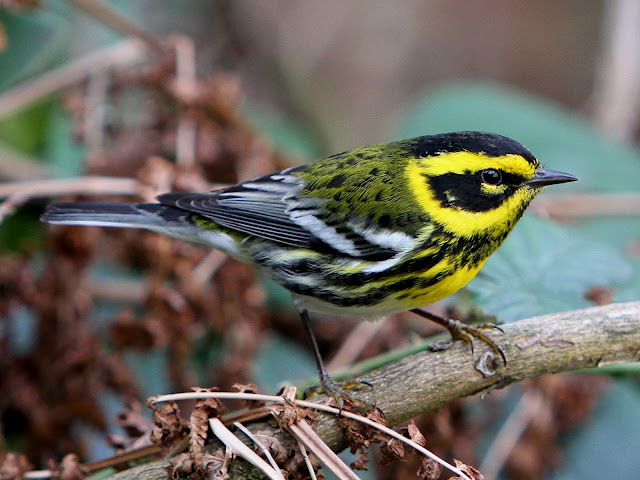Who’s that small warbler-sized bird with yellow and black on its head feeding on my suet, here in the dead of winter? That’s a Townsend’s Warbler!
The male’s yellow head with the black ear patch and black throat, plus the blackish cap really make the yellow pop. The male has a black throat above his yellow breast, and black streaks on the sides of the breast. The female has similar markings, except her black is so pale it looks almost greenish, and her throat is bright yellow. Both males and females have a yellow spot directly under their eyes.
 |
| Female Townsend's photo by Craig Kerns |
They are at home from sea level to subalpine forests, building their nest for 3-5 eggs more than 30 feet up (third-story building height) on a main limb of an evergreen.
The brightly colored males sing their buzzy territorial songs from the top of tall evergreens, making it frustratingly hard to see them while hiking amongst tall conifers.
The brightly colored males sing their buzzy territorial songs from the top of tall evergreens, making it frustratingly hard to see them while hiking amongst tall conifers.
Townsend’s love caterpillars, especially spruce budworms. They glean lots of insects from conifer needles and buds, plus occasionally catching insects on the wing.
 |
| Female Townsend's on suet. Photo by Craig Kerns |
Most Townsend’s Warblers migrate to Mexico or Central America during the winter, but a smaller population stays year-round in western Washington and Oregon.
These hearty warblers come down lower to find wintering bugs, and will readily eat suet, mealworms and peanut butter.
They still need lots of evergreen cover, and liquid water, so only come to yards that supply those requirements.
Why don’t you see them much in the summertime?
 |
| Male watching. Photo by Craig Kerns |
Yellow is a surprisingly effective camouflage coloring, especially if a yellow bird is pursuing bugs in trees with yellow in their leaves, like weeping willows, and alders.
Habitat loss is the number one cause of species declines, and logging of old growth, and the cutting down of large, tall neighborhood trees seem to be affecting some Townsend’s populations.
Watch your suet feeders, put out mealworms and peanut butter, and you may see these warblers in your yard all year long. They don’t stay long, but they will return repeatedly once they have found a reliable food source. Enjoy—you should be so lucky.


Yes! We've had a family overwintering here in Gig Harbor visiting our suet all winter long for several years. We're lucky enough to have our house snuggle amongst tall Douglas fir and Western red cedars.
ReplyDeleteSo exciting to know this! I am in my shop and have plants outside the window and this beautiful little guy came down to eat some bugs out of the plants. I had never seen one before so I looked it up. Thanks for posting this info about this beautiful little creature! Carolyn Ackerman, Petunia's Place in Newport, Oregon
ReplyDeleteJust saw one and his little family in my back yard here in Ventura CA. They are beautiful!
ReplyDeleteJust saw one of these little guys in our front yard in Waldport, Oregon. So small and fast when flitting around searching for tasty treats.
ReplyDeleteJust saw a pair visiting our little water feature in the yard here in Newport, OR.
ReplyDeleteI just saw one out my window in Renton, WA. I had to look it up. Thanks for the info.
ReplyDeleteThanks so much for sharing this information. Based on the description, I'm feeling pretty confident about having seen a female at my suet feeder this afternoon in W. Seattle. Delightful!
ReplyDeleteDowntown Seattle- they are visiting my little balcony as of about a week ago! So pretty!
ReplyDeletewarblers! So many coming to my bird bath...for many, many months now...I'm in Hayes Valley neighborhood
ReplyDeleteI've had a couple at my suet feeder past couple weeks in Mountlake terrace.
ReplyDeleteI am in SoCal and saw one here recently. I took video because I don’t recall seeing a bird like this here before. It was a male. I am not a “Birder”, but love all things nature and am always looking for things I have yet to see before like this Warbler.
ReplyDeleteJust saw a male flitting quickly among the low tread and shrubs in San Diego. Beautiful little guy.
ReplyDeleteI have a beautiful male one visiting my suet feeder in SW Portland.
ReplyDeleteTorrance CA here, just saw one today on my backyard fountain!
ReplyDelete